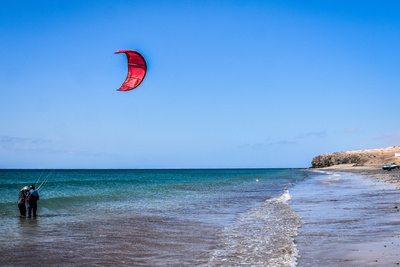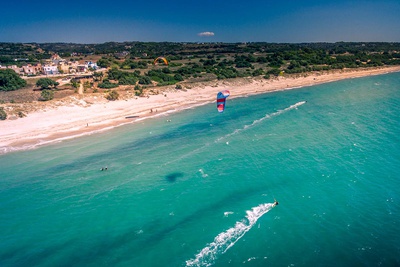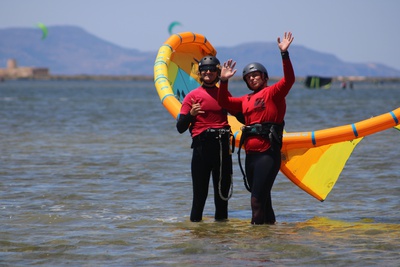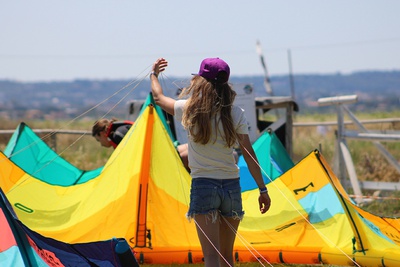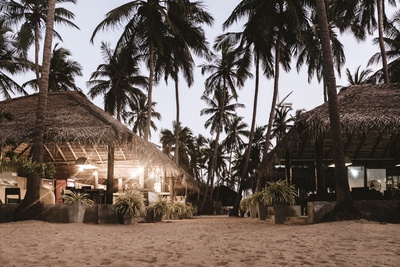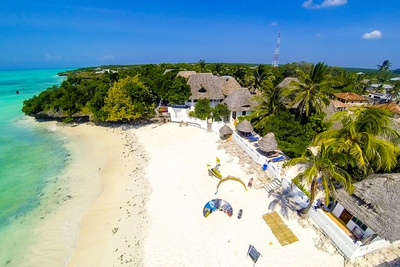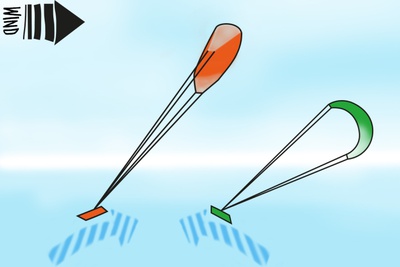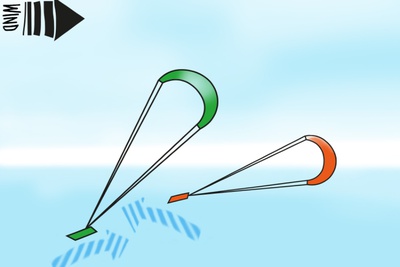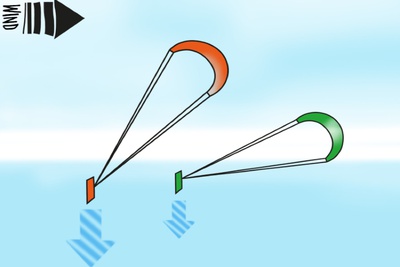Learn Kitesurfing
Kitesurfing (also called kiteboarding or kiting), is an action-packed sport that every active person can learn and nobody is too young or too old. The assumption that you need a lot of strength and well-trained muscles for kitesurfing is also false as kiters wear a harness that distributes the power to the whole body, not just the arms. When learning, a seat harness is usually used to help you get used to the sensation, meaning kitesurfing is accessible and for everyone.
The feeling of the wind carrying you over the water is incredible and you don’t need any previous knowledge. However, it’s important that you learn with a reputable and licensed kitesurfing school. Kites have become much safer in recent years, but to get the best out of learning with fast safe progression, a special kitesurfing holiday provides the optimum experience. It is especially recommended to learn kitesurfing on holiday, for many reasons. Starting with the fact that you usually have enough time and peace to learn kitesurfing on a kitesurfing trip. In addition, it is of course much more fun at kitespots with constant wind and warm water than in the cold North Sea.
We’ve listed the most frequently asked questions about learning and have tried to answer as fully as possible.
Have fun learning to kitesurf!
Summary
Kitesurfing, or kiteboarding, is currently one of the coolest sports you can do on the water. Not only will you experience the ultimate feeling of freedom as soon as you are able to ride the first few metres, but kitesurfing is also super easy to learn and with the right kitesurfing course, progress is fast.
Kitesurfing is also a very varied sport where you can either cruise on flat water lagoons, jump or practice tricks, or even kite in waves with a surfboard. In recent years there’s been a lot of hype about kitefoiling where you glide above the surface of the water on a hydrofoil. Here, a wing and mast mounted underneath the board prevents resistance meaning you can kite in low winds from just 8 knots!
Kitesurfing is never boring and even if you are a bit overwhelmed after your first kitesurfing course, you will quickly find your own kiting style and make fast progress.
Kitesurfing requires much less equipment than for windsurfing. The kitesurf boards are much smaller and have no volume (except wave boards) and fit in even the smallest car. The kites can be folded into their own handy backpacks, and at the start, you won’t need more than two different sizes of kite.
It’s advisable not to buy your own equipment before your kitesurfing course as professional kite centres will provide what you need to the latest safety standards. Besides a board and kite you will also need a wetsuit, harness, helmet and buoyancy vest. Depending on the season or kitesurfing area you will also need neoprene shoes. These little things will also be provided when you take a kitesurfing course.
Yes!
If you are a kitesurfing beginner, it will be difficult or impossible for you to know how to spot any danger when learning to kitesurf. This starts with choosing the right kite for the wind speed and ends with general weather and location knowledge. The international hand signals and priority rules are also very important on the water because nobody will hear you screaming ‘out of the way!!!’ at 25 knots.
When you take a professional kitesurfing course you will not only learn to ride the first few metres on the board, but also important topics such as the safe assembly and dismantling of your equipment, a spot check, and of course all the rules on the water.
We recommend that you combine the kitesurfing course with a kitesurfing holiday to ensure you are already in a relaxed mood and can concentrate on your progress on the water.
If you are looking for a reputable kite school, you should pay attention to the following points:
All teachers must be certified. Reliable certificates are from the VDWS and the IKO. Here you can be sure that your kitesurfing instructor has qualified training and can safely teach you how to kitesurf.
Pay attention to the equipment provided by the kite school. It should not be older than one season and there should be no signs of wear such as worn lines or cracks in the canvas. You’re at the right school when they also teach you safety topics such as the professional assembly and disassembly of kite equipment, correct take-off and landing with the corresponding hand signals, as well as a spot and weather assessment.
It is better to book a course that takes longer than three days. They’re more expensive than a trial session or three-day course, but it’s much more likely that after five to seven days you will be able to waterstart and ride a few metres. Then if you feel safe you can continue to practice on your own or take an advanced course. All KiteWorldWide centres offer you excellent conditions to learn kitesurfing.
But why do you find the best conditions to learn kitesurfing during your kite holiday? Licensed VDWS trainers offer you the best possible help to achieve your first successes on the kiteboard. During your holidays you will learn to kitesurf in a relaxed way and without time pressure. Learning kitesurfing in our selected kitespots offers a big advantage, the wind is constant and therefore ideal to learn kitesurfing. Just like the small training groups and the individual help. If you learn kitesurfing on holiday, you don’t have to worry about falling into the water. The warm water temperatures or even shallow lagoons are not only a paradise for kitesurfing beginners. Such lagoons can be found on Djerba, in Dakhla, Egypt or Sicily.
Whether you travel alone or in a group, the community feeling is guaranteed. Everyone, whose heart beats for kitesurfing or who want to learn new kitesurfing, comes together here. You will also experience the unique culture and breathtaking landscape of a country – either by learning to kitesurf on the water or one of the many other activities. Whether exploring the beautiful old town of Essaouira, snorkeling in the turquoise waters of Zanzibar or a jungle safari in Kalpitiya. If there is no wind to learn kitesurfing, there are still many other adventures to experience.
Kitesurfing has become safer and safer in recent years and there’s nothing to stop you from learning if you can swim safely and have a normal fitness level. Nevertheless, do yourself and the other kiters a favour and make sure you take a professional kitesurfing course. Here you will learn to kitesurf safely and how to avoid putting yourself and others in danger.
In the beginning, you won’t need your own kite equipment. It would be hard for you to choose between all the different brands, shapes and designs and there is a high probability that you will buy the wrong equipment. This makes it more difficult for you to learn a sport that is supposed to be fun!
As mentioned before, reputable kitesurfing schools will have the latest learning equipment. If you feel comfortable with the equipment after your course, just talk to your trainer about which kite and which board he or she can recommend to you.
You will need the following equipment at some point in your kite career:
- Kites (at least two different sizes, or preferably more)
- Kiteboard (twintip or wave board, or both…according to taste)
- Bars (including lines)
- Harness (in the beginning you’ll use a seat harness, later a waist harness)
- Helmet
- Wetsuit (unless you are not travelling to warmer countries like Brazil or Zanzibar)
Join Anne and Tabea from the KiteWorldWide office in Hamburg for a complete kitesurf beginners guide which includes 12 short videos.
Attention: This course is not intended to replace a course provided by a professional kitesurf school. It should only serve you as preparation for a kitesurf course or as a refresher. To learn kitesurfing in a safe environment, you should attend a course provided by a certified kite school.
Have a look at our hand-picked destinations for beginners, where we offer the perfect learner packages to suit you. They’re all locations with a high probability of wind, combined with nice weather and optimum spots for learning.
A special thanks to our media partner Gleiten.TV for the production of this tutorial.
Which kitesurfing destinations are suitable for learning to kite?
The following destinations are suitable for beginners
Kitesurfing in Costa Calma, Fuerteventura
Fuerteventura is the perfect place for a kite trip in summer as well as in winter and offers the best conditions for every level. In the kite centre the atmosphere is very familiar and the kite instructors are at your disposal with advice and support.
There are also different types of accommodation, where everyone is sure to find a suitable spot!
Kitesurfing in Greece - Kos
Mastichari on Kos is the new spot for everybody that wants to get into the world of kitesurfing or to improve his or her skills.
Nice kiteschool, beautiful accommodation and ideal also for families. Season is from April to October.
Kitesurfing in Italy - Sicily
A huge lagoon with throughout flat and shallow water throughout. The short distance to the African continent is responsible for the warm and pleasant temperatures from March until November.
On top of that two different wind systems, which create constant wind.
Kiteboarding events Sicily
The Kite Learn Event in Sicily in cooperation with Kiteboarding Events - Exclusive at KiteWorldWide.
You can expect the experienced Kiteboarding Events trainer team, a huge material pool with test kites and boards of different brands and of course support by the KiteWorldWide team on site.
Kitesurfing in Egypt - Seahorse Bay
Our Kitesurf Spot in Egypt - between Hurghada and El Gouna, Hotels directly at the Spot, brandnew Kite Center with F-One gear, Flatwater lagoon with shallow water - limited spaces for more space on the water!
Great kitesurfing conditions in March, April, June, July, September, October and November!
Kitesurfing in Sri Lanka - Kalpitiya
KiteWorldWide Lagoon Lodge Sri Lanka / Kalpitiya. Comfortable lodge located right at the huge flat water lagoon with extreme high wind guarantee and two seasons: from May until October and from December until March.
Kitesurfing in Brazil - Tatajuba
Empty spots, wind and kiting, kiting, kiting! The little paradise, called Tatajuba, pleases everyone with one of the best shallow water spots and the most reliable and strongest wind of Brazil!
Kitesurfing at Zanzibar – Jambiani
Discover this awesome kite-island with KiteWorldWide! Crystal clear turquoise water, steady winds and huge flatwater areas await you from december to march and july to october.
The perfect spot to learn kitesurfing
When on a quest for a suitable spot to learn to kitesurf, you’ll constantly hear numerous people giving various opinions on what makes a perfect spot, even though locations are usually quite different from one another.
We have gained a lot of experience from running six kite schools in various destinations, and offer some basic tips to keep in mind when looking for the perfect spot.
LIGHT WIND VS. STRONG WIND
The most important factor to learn kitesurfing is a high wind probability. It doesn’t matter where you are, if you don’t have wind, you won’t be able to complete a course. We have learnt that the power of wind is rather unimportant and everything from 12 till 40 knots works.
Nowadays smaller and larger kites work very well to give control, safety and re-launch capabilities. Typical light wind areas preferred by our kitesurfing beginners are Zanzibar or Kos in Greece.
Many say that strong winds can be problematic but we disagree, as usually, the only trouble is gusty wind. In Tatajuba (Brazil), one of our learning destinations, we had positive experiences teaching with strong wind. Here, there is almost a 100% chance of strong wind and we mostly practice on 3-7m kites but see constant learning success from our students.
SHALLOW WATER VS. DEEP WATER
A lot of people say that you need shallow water to learn kitesurfing. The truth is, that it gives beginners a certain secureness and that it does support progress during the first hours. However, to avoid injuries, you should watch out not to land with your feet first and it’s very important to practise in deep water too. You can find flat water spots for learning in Egypt, Dakhla in Morocco, Kalpitiya in Sri Lanka and Zanzibar.
Deepwater is not a barrier for professional kite schools. In Tarifa or Kos (Greece), you will also find many schools teaching professionally in deep water. We also know some areas where the wind blows cross-onshore and the water only becomes deep gradually so that you can stand the first 50-100m but at the same time you get a good feeling for deepwater (e.g. for body dragging). Example areas are found in Essaouria or the Langebaan lagoon near Cape Town.
